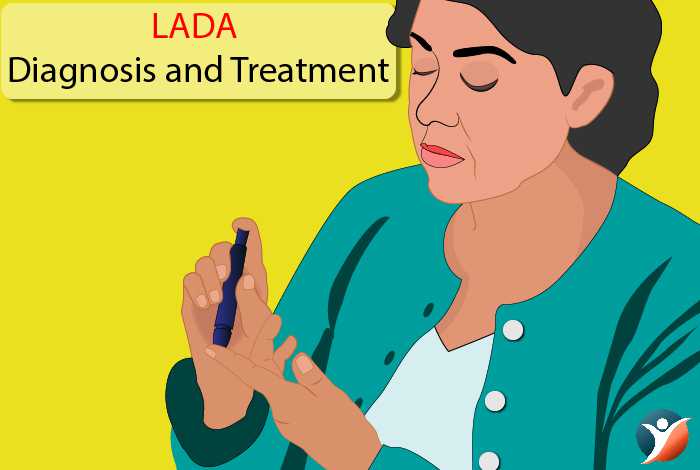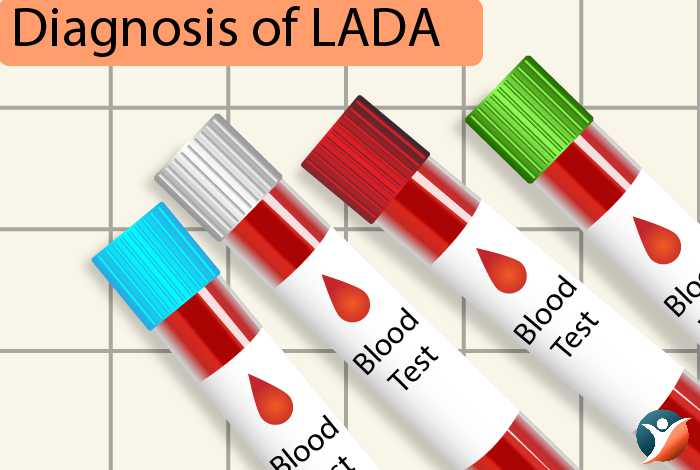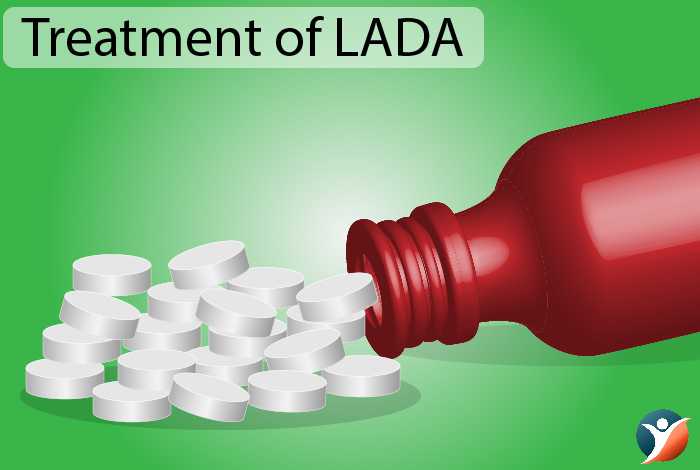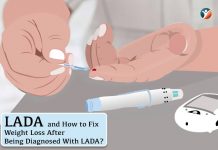
What is Type-1.5 Diabetes (LADA)? How Do You Diagnose it And What Are The Treatments Available?

Recently diagnosed with diabetes but your sugar levels are not budging even when you are on medications? Or losing pounds faster without any conscious efforts? Feeling exhausted most of the day? If your answer is in affirmative, we would like to burst this bubble now. This might be actually Type 1.5 diabetes or LADA and not Type-2 diabetes.
Ah! Never heard of Type 1.5 diabetes? Well, it is a form of type 1 diabetes, which is symptomatically similar to type-2 diabetes. Even if you have LADA, chances are that you would have been already mis-diagnosed as a type-2 patient. Read-on to know about LADA, how is LADA diagnosed and how it can be treated.
Table of Contents:
- What is LADA?
- Diagnosis of LADA
- Treatment of LADA
- Differentiating Between Different Types of Diabetes
- Characteristics of LADA
- Complications Related To LADA
- Conclusion
What is LADA?

LADA is the abbreviation for Latent Autoimmune Diabetes of Adulthood. It is actually a form of type-1 diabetes which is diagnosed much later in the adulthood. Apparently, LADA develops much more gradually than type-1 diabetes. Because of this, it is more often misdiagnosed as type-2 diabetes.
Scientifically speaking, LADA is initially a non-insulin requiring diabetes. It is diagnosed in people generally between 30 to 50 years of age who usually have antibodies to glutamic acid decarboxylase (GAD).
Simply put, it occurs due to an autoimmune reaction wherein the body produces antibodies against its own insulin-producing beta-cells. This eventually leaves body with little or no insulin.
Initially, insulin is not required but as the disease progresses, a patient might need to take additional insulin. It is a form of type-1 diabetes because it is majorly contributed by autoimmune process but is symptomatically similar to type-2 diabetes. Hence, it is commonly known as type-1.5 diabetes or LADA. Few other names for LADA include late-onset autoimmune diabetes and slow-progressing type 1 diabetes.
LADA is more common than you think it is. Nearly 10 percent of people with diabetes have LADA, making it even more common than type-1 diabetes. Few people with LADA have a long “honeymoon” period as their bodies continue to produce insulin without any medicine.
Diagnosis of LADA

Since people who have LADA are initially misdiagnosed as type-2 diabetes, they have to undergo routine tests for diabetes diagnosis. A diabetes diagnosis is made only when one of the below tests is positive. The results can, however, be confirmed when another test is positive on a different day.
- If your A1C either equal to or greater than 6.5 percent or
- If your plasma glucose (fasting) is either equal to or greater than 126 mg/dL or
- If your Oral glucose tolerance test (OGTT) result is either equal to or greater than 200 mg/dL or,
- If your plasma glucose (casual), that is taken randomly at any given time is either equal to or greater than 200 mg/dL
A diabetes diagnosis can be made. While, if a doctor believes that it is LADA and not type-2 diabetes, further tests need to be conducted to confirm upon the same.
The Immunology of Diabetes Society has set the following criteria for diagnosing LADA:
- Person must be greater than age of 30
- Positive test for at least one of the four antibodies that are commonly found in type-1 diabetes patients
- Have not required any treatment with insulin within the first 6 months of diabetes diagnosis.
Individuals with LADA have almost same degree of insulin resistance and blood sugar control as in people with Type-2 Diabetes. Nevertheless, LADA can be distinguished from type 2 diabetes by the presence of islet autoantibodies that are more commonly present type 1 diabetes patients. Type 1 diabetics commonly have one or more of the four islet autoantibodies namely glutamic acid decarboxylase autoantibodies (GADAs), islet cell antigens (ICAs), or tyrosine phosphatase proteins (IA-2s). However, patients with LADA generally have only one autoantibody. For diagnosing LADA, it is crucial to test for the below self-antibodies (autoantibodies).
- Autoantibodies to Islet Cell Antigens (anti-ICA) are present
- Autoantibodies to glutamic acid decarboxylase or GAD are present.
- Autoantibodies to insulin are present
- Autoantibodies to tyrosine phosphatase proteins (IA-2s) are present
- Low level of a biomarker, C-peptide, which is even more low in people with type-1 diabetes and normal in people with type-2 diabetes
Since one autoimmune disease increases the risk of another autoimmune disorders, LADA might be the case if a person has common symptoms of diabetes and also has another autoimmune disease like rheumatoid arthritis, Hashimoto’s thyroiditis, lupus, celiac disease, or any other autoimmune disorder.
Now, that you know how LADA is diagnosed, let’s learn how to treat LADA both conventionally and naturally.
Treatment of LADA (Type 1.5 Diabetes)

After you are diagnosed with LADA, it is extremely important to manage LADA with various treatment options available. Broadly speaking, we can classify the LADA treatment and management into two categories: conventional and natural. Let’s get straight into what these are and what all they consist of.
Conventional Treatment:
LADA often does not require additional insulin at time of diagnosis and might be easily managed with certain changes in lifestyle such as eating right, exercise, and, if possible, weight loss. However, few clinicians believe that it is much better to start insulin at onset or soon after rather than using diabetes pills for initial treatment.
Initially, a person with LADA might positively respond to oral diabetes medications, lifestyle changes and eating right although his or her beta cells continue to suffer damage. LADA patients should be monitored closely, to keep their blood sugar levels in check.
Whether you have been diagnosed with type 2 diabetes or have developed LADA, you will require almost same treatment:
- Weight control
- Proper diet
- Appropriate exercise regimen
- Oral diabetes medications
- Other medications, if required
- Insulin replacement therapy
- Regular monitoring of hemoglobin A1c levels
According to the guidelines, doctors should effectively manage LADA with type 2 diabetes medications and recommended dietary modifications for six months after LADA diagnosis. These medications include:
- Metformin may be used but it is still not used as a stand-alone therapy.
- Glucagon-like peptide 1 receptor agonists, including liraglutide, exenatide, dulaglutide, lixisenatide, albiglutide and semaglutide.
- Dipeptidyl peptidase-4 inhibitors (DPP-4 inhibitors) such as linagliptin, sitagliptin, and saxagliptin.
- Thiazolidinediones, including rosiglitazone and pioglitazone
While, type 2 diabetes drugs known as sulfonylureas are not used as first-line for LADA treatment as they might damage beta cells and possibly worsen glucose control. These drugs include chlorpropamide, glyburide, glimepiride, glipizide, glipizide, glyburide and tolazamide.
But unfortunately, beta cell destruction continues and people with LADA eventually require insulin therapy, generally from 6 months to 5 years after its diagnosis. Let’s learn more about insulin therapy.
Insulin therapy may be recommended if you do not respond fully to dietary modifications and exercise or other oral medications. There are 4 types of insulin based on how quickly an insulin begins to work, its peak time when it has maximum effectiveness and for how much time it remains effective in the body. Insulin might act differently for different people. Below is a table that summarizes different types of insulin.
| Attributes/Insulin Types | Rapid acting | Short acting | Intermediate acting | Long acting |
| Onset | 15 minutes | 30 to 60 minutes | 1 to 3 hours | 1 hour |
| Peak time | 30 to 90 minutes | 2 to 4 hours | 8 hours | none |
| Duration | 3 to 5 hours | 5 to 8 hours | 12 to 16 hours | 20 to 26 hours |
You can use different insulin injecting devices such as insulin pen, insulin pump and syringe to administer insulin.
With this, we should pay heed to natural ways that can help in managing LADA and possibly preventing diabetes complications.
Natural Ways/ Home remedies:

In order to reduce or eventually eliminate the diabetes drugs, you need to strictly follow the below recommendations. These would surely help in managing blood sugar levels while adressing most of the autoimmune causes.
1. Eat Right Foods to Manage Your Skyrocketing Blood Sugar: Well, food choices can really help you in keeping your blood sugar levels under check. Read-on to know which foods you must incorporate in your diet, right away.
- Make sure you add certain key foods and essential supplements in your diet. These would help to combat most of the autoimmune diseases (such as leaky gut). These foods include fermented vegetables, bone broth, wheat grass, chlorella, extra virgin coconut oil, l-glutamine, spirulina, unprocessed cod liver oil and collagen protein powder.
- Consume herbs, foods and other compounds that have great antiviral properties. These include licorice root, echinacea, onions, astragalus, garlic, turmeric, lemons, medicinal mushrooms, extra virgin coconut oil and colloidal silver.
- Always consume well-balanced diet with low glycemic load and low glycemic index.
- Consume more of fruits, vegetables, starchy foods that have enough fiber, healthy fats, lean proteins and whole grains. Try to consume more raw fruits.
- Avoid over-eating meat as it requires various digestive enzymes to digest completely. Undigested meats would be just be stored as fat and also would spike blood sugar.
- Limit alchohol and caffiene intake.
- Drugs are a strict no-no.
- Include various anti-inflammatory foods like wild salmon, blueberries sardines, and extra virgin olive oil, in your diet.
- Avoid all the possible “trigger” drugs, foods, chemicals, and toxins that might trigger any autoimmune response or damage to the beta cells. Common triggers include white flour, gluten, wheat, cow’s milk, grains, vegetable oils, most dairy, legumes, canola oil, nuts, certain diabetes drugs, and few other OTC or prescription drugs.
- Use raw juicing to ensure that key nutrients reach your body cells. This would in-turn re-balance and strengthen your immune system.
- Regularly go for a cleanse and detox, to eliminate accumulated toxins that might contribute to oxidative stress and cellular inflammation.
- You can consider supplementing you diet with supplements including vitamin D3, vitamin B complex and l-glutamine. However, always ask your doctor before starting any supplement and try to obtain the essential nutrients from your food rather than taking supplements.
- Try incorporating various foods in your diet as they help in regenerating the insulin-producing beta cells. These foods include avocado, barberry, goldenseal, bitter melon, turmeric, black cumin, broccoli and swiss chard.
- It is advised to check your blood sugar levels prior to every meal you consume.
2. Exercise Daily To Become Fitter and Healthier: You should consult your doctor to tailor-make a suitable exercise regimen for you. It would be best if your doctor performs follow-up evaluations to ensure that you are adhereing to the plan. Exercising is indeed a great way to both build and retain your muscle mass. It also helps in utilization of excess blood sugar. When you indulge in mild to moderate physical activity, your pancreas need not create as much glucagon and insulin. Exercise at-least 5 times a week, around 45 minutes to one hour each session. Make sure you exercise at-least after one to two hours after you have had your meal. You can also try mild to moderate weight training and resistance training, after consulting your doctor.
3. Sleep Better to Improve Insulin Sensitivity: Lack of sleep can possibly lead to weight gain and simultaneously reduces your insulin sensitivity.
In a study conducted at Yale school of Medicine which had 1,709 male participants, those who averaged only five to six hours of sleep each night doubled their risk of diabetes. Similar researches in women showed similar results.
4. Get Some Help, If You Are Stressed or Depressed: If you are stressed or depressed, you would find it difficult to eat healthy or exercises. But, the dangers of being depressed don’t end here. Surprisingly, depressed women have around 23 percent more insulin resistance than women who aren’t depressed irrespective of their body weight, age or excercise habits.
5. Drink lots of Water: People with LADA have larger number of ketones than people with type-2 diabetes. The more insulin produced, the more ketones will be produced thereby leading to eventual pH imbalance in the body. People under 5’3” should consume at-least 48 ounces of water each day and those over 5’3” must consume 64 ounces of water each day. Ketoacidosis is a short-term health complication related to LADA, specially once when the pancreas has lost its ability to produce sufficient insulin. LADA patients should be aware of the symptoms and signs of ketoacidosis and also how to test ketones if required.
These treatments can help you in effectively managing your blood sugar levels. While, what suits you best; medications, natural ways or both can only be decided best by your doctor.
Differentiating Between Different Types of Diabetes
To make it easier for you to easily differenciate bewteen all the types of diabetes, we have prepared a simple chart.
| Attributes/Types | Type-1 | Type 1.5 Diabetes (LADA) | Type-2 |
| Typical Age of Onset | Youth or Adult | Adult | Adult |
| Insulin Dependence | Within days or weeks | Within 6 years | Within years, if at all |
| Presence of Autoantibodies | Yes | Yes | No |
This chart would make it easy to understand the basic difference between different types of diabetes, while highlighting the attributes each types has.
Characteristics of LADA (Type 1.5 Diabetes)
LADA is characterized by the following:
- A lack of family history of type 2 diabetes
- Onset of LADA is usually at the age of 25 or older.
- Gradual increase in insulin requirements
- Positive test for autoantibodies
- Decreasing ability to produced insulin as also indicated by low C-peptide
- Body mass index <25kg/m2
- Personal history of autoimmune disease
- Human leukocyte antigen (HLA) genes that are generally associated with type 1 diabetes are present in people with LADA but not in type 2 diabetics
- Family history of autoimmune diseases
All of these indicate that you have LADA and not type-2 diabetes or any other form of diabetes. However, the symptoms and signs of LADA are almost similar as in type-2 diabetes.
-
- Unusual thirst
- Frequent urination
- Blurred vision
- Weight loss
- Increase in appetite
- Vomiting
- Nausea
- High blood sugar levels
- Extreme weakness or fatigue
- Irritability and mood changes
- Frequent skin and bladder infections that take too much time to heal
- Loss of feeling or tingling in the hands or feet
- High levels of sugar in urine
- Dry and/or itchy skin
Complications Related To LADA
The long-term complications of LADA are similar to what people with type 1 and type 2 diabetes may also experience. The possible health complications of diabetes include the following:
- Heart disease
- Stroke
- Nephropathy (related to kidney)
- Retinopathy
- Neuropathy (related to nerves)
- Ketoacidosis
- Foot problems
If you don’t efficiently keep a check on your blood sugar levels. You can too expect these health complications. Hence, it is extremely crucial to manage you diabetes.
Conclusion
Diabetes has always been and is still a dreaded health condition but thankfully, a person can lead very much normal life with it. LADA is also known as type 1.5 diabetes, as it is a form of type-1 diabetes and shares similar symptoms with type-2 diabetes. While, it is quite easy to diagnose type-1 or type-2 diabetes, LADA can be relatively difficult to diagnose.
Generally, LADA in most cases is misdiagnosed as typical type-2 diabetes. This makes it even more important to diagnose LADA properly. We hope our article would have given you an idea about how to diagnose LADA and how to treat it. We would still request you to consult your doctor before making any drastic changes in your diet or lifestyle, for managing your diabetes.
Did you enjoy the article? We look forward to your comments for feedback and suggestions. If you have any additional information or advice, please leave your comment below. We would love to share more advices and information with you soon.





